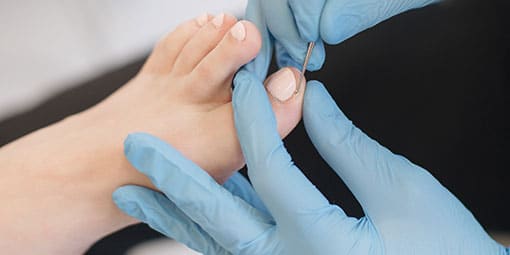
If you want to run with an ingrown toenail, it is important to take certain precautions to avoid worsening the situation and protect your foot from possible injuries.
Table of Contents, Running with an ingrown toenail
An ingrown toenail is a common problem that occurs when the toenail grows abnormally and slips under the skin. This can be very painful and can lead to infection if left untreated.
As a complication, it is not recommended to perform physical activity with an ingrown toenail, as this can cause pain, additional bleeding, and worsen the state of the toenail.
The repetitive motions associated with exercise can increase the pain and itching caused by the ingrown toenail.
Exercise can also increase pressure in the toes, causing additional bleeding.
Since ingrown toenail is more vulnerable to infections, exercise can spread bacteria from the skin to the toenail, increasing the risk of infection.
Finally, the friction and pressure exerted on the toenail during exercise can worsen the state of the toenail and make healing more difficult.
Therefore, it is better to consult a podiatrist or doctor to treat the toenail before resuming any physical activity.
IT IS IMPORTANT TO RECOGNIZE THE SIGNS AND SYMPTOMS OF AN INGROWN TOENAIL IN ORDER TO TREAT IT EFFECTIVELY
· Here is a list of the most common symptoms associated with this condition.
· Pain at the level of the toenail when walking or applying pressure to the affected area.
· Swelling and redness around the toenail. Swollen and sensitive skin around the toenail.
· Pus or fluid discharge from the toenail.
· Difficulty putting on or taking off a shoe due to pain or swelling.
· Toenail that is crooked or has an abnormal shape.
IF YOU SUFFER FROM AN INGROWN TOENAIL AND WANT TO CONTINUE RUNNING, IT IS IMPORTANT TO FOLLOW ADVICE TO AVOID COMPLICATIONS AND PROMOTE HEALING.
· Use good quality running shoes with adequate support for the arch and heel. This will properly distribute pressure on your foot and avoid applying too much pressure on the ingrown toenail.
· Wear thick and good quality socks to protect your foot from friction and rubbing.
· Use foam or silicone protection on the toenail to avoid any contact with the ground while running.
· Avoid running on uneven or rough surfaces, which can exert additional pressure on the toenail.
· If you have sweating issues, use an antifungal to prevent any skin infections.
IT’S IMPORTANT TO UNDERSTAND THE RISKS ASSOCIATED WITH RUNNING WITH AN INGROWN TOENAIL TO AVOID COMPLICATIONS AND PROMOTE HEALING.
In this section, we will explore the different risks related to this condition and how to manage them effectively.
· Pain can be very bothersome and can prevent you from running effectively or maintaining your usual pace.
· Ingrown toenail can cause swelling and skin irritation, making running uncomfortable and difficult can lead to infection if not properly treated.
· Infections can be serious and may require antibiotics for healing.
· Ingrown toenail can cause pain and discomfort when wearing shoes, making running difficult.
SHOE SELECTION
Shoe selection can help control an ingrown toenail while running in various ways.
Firstly, by wearing shoes that fit well and offer good support to the arch of your foot, you can reduce pressure on the ingrown toenail.
Shoes with a cushioning midsole and reinforced heel can also help distribute pressure more evenly, thus reducing pressure on the toenail.
Finally, by wearing running shoes with wider and more spaced out toes, you can reduce friction on the toenail.
It is important to note that using appropriate socks can also help avoid friction and rubbing on the ingrown toenail.
It is essential to consult a podiatrist to find the best shoes for you if you are suffering from an ingrown toenail.
THERE ARE SEVERAL EASY TREATMENTS YOU CAN DO IF YOU SUFFER FROM INGROWN TOENAIL AND YOUR PAIN INCREASES AFTER RUNNING:
Apply ice: Apply a cold compress to the toenail to reduce swelling and pain. Use silicone bandage: Use a silicone bandage to protect the toenail and reduce pressure.
Elevate your foot: If possible, elevate your foot to reduce pressure on the toenail and promote blood flow. Use painkillers: Use painkillers such as ibuprofen to relieve pain.
Consult a podiatrist: If you notice your symptoms worsen or don’t improve after a week, it is important to consult a podiatrist to evaluate the toenail’s state and to prevent complications.
Treatment may include toenail resection, application of antifungal medications, or surgery.
If the toenail is very painful or there is an infection, it may be necessary to take antibiotics to prevent the infection from worsening.
In summary,
it is important to take certain precautions to avoid worsening the situation and protect your foot from possible injuries.
If you have persistent problems, consult a doctor or podiatrist for adequate treatment.
It is better to schedule an appointment with one of our podiatrists to treat your foot to avoid contaminating others around you and ensuring proper care to counter the infection.
